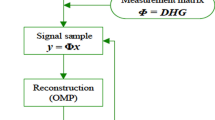Abstract
An approach is proposed for producing compressed sensing (CS) matrices via multidimensional pseudo-random sequences. The columns of these matrices are binary Gold code vectors where zeros are replaced by −1. This technique is mainly applied to restore sub-Nyquist-sampled sparse signals, especially image reconstruction using block CS. First, for the specific requirements of message length and compression ratio, a set Λ which includes all preferred pairs of m-sequences is obtained by a searching algorithm. Then a sensing matrix A M×N is produced by using structured hardware circuits. In order to better characterize the correlation between any two columns of A, the average coherence is defined and the restricted isometry property (RIP) condition is described accordingly. This RIP condition has strong adaptability to different sparse signals. The experimental results show that with constant values of N and M, the sparsity bound of A is higher than that of a random matrix. Also, the recovery probability may have a maximum increase of 20 % in a noisy environment.






Similar content being viewed by others
References
A. Amini, F. Marvasti, Deterministic construction of binary, bipolar, and ternary compressed sensing matrices. IEEE Trans. Inf. Theory 57(4), 2360–2370 (2011)
E.J. Candès, The restricted isometry property and its implications for compressed sensing. C. R. Math. 346(9–10), 589–592 (2008)
E.J. Candès, T. Tao, Decoding by linear programming. IEEE Trans. Inf. Theory 51(12), 4203–4215 (2005)
E.J. Candès, M.B. Wakin, An introduction to compressive sampling. IEEE Signal Process. Mag. 25(2), 21–30 (2008)
E.J. Candès, J. Romberg, T. Tao, Robust uncertainty principles: exact signal reconstruction from highly incomplete frequency information. IEEE Trans. Inf. Theory 52(2), 489–509 (2006)
R. DeVore, Deterministic constructions of compressed sensing matrices. J. Complex. 23(4–6), 918–925 (2007)
D.L. Donoho, Compressed sensing. IEEE Trans. Inf. Theory 52(4), 1289–1306 (2006)
R. Gold, Optimal binary sequences for spread spectrum multiplexing. IEEE Trans. Inf. Theory 13(4), 619–621 (1967)
V.D. Goppa, Codes on algebraic curves. Dokl. Akad. Nauk SSSR 259(6), 1289–1290 (1981)
S.D. Howard, A.R. Calderbank, S.J. Searle, A fast reconstruction algorithm for deterministic compressive sensing using second order Reed–Muller codes, in Proc. IEEE Annual Conf. Inform. Sciences and Systems (CISS), Mar (2008), pp. 11–15
S. Li, F. Gao, G. Ge, S. Zhang, Deterministic construction of compressed sensing matrices via algebraic curves. IEEE Trans. Inf. Theory 58(8), 5035–5041 (2012)
S. Rao, The theory of cyclic codes and preferred pairs of m-sequences. J. Telem. Track. Command. 11(3), 9–14 (1990)
C.E. Shannon, Communication in the presence of noise. Proc. Inst. Radio Eng. 37(1), 10–21 (1949)
M. Shen, W. Liu, Image reconstruction technique based on the compressed sensing theory. Electron. Sci. Tech. 24(3), 9–12 (2011)
J.A. Tropp, A.C. Gilbert, Signal recovery from random measurements via orthogonal matching pursuit. IEEE Trans. Inf. Theory 53(12), 4655–4666 (2007)
M.B. Wakin, M.A. Davenport, Analysis of orthogonal matching pursuit using the restricted isometry property. IEEE Trans. Inf. Theory 56(9), 4395–4401 (2010)
Z. Wan, Algebra and Coding Theory (Higher Education Press, Beijing, 2007)
L.R. Welch, Lower bounds on the maximum cross-correlation of signals. IEEE Trans. Inf. Theory 20(3), 397–399 (1974)
N.Y. Yu, Deterministic compressed sensing matrices from additive character sequences (2010). arXiv:1010.0011vl [cs.IT], Sept
N.Y. Yu, Deterministic compressed sensing matrices from multiplicative character sequences, in Proc. IEEE Annual Conf. Inform. Sciences and Systems (CISS), Mar (2011), pp. 1–5
Acknowledgements
The authors would like to acknowledge funding support from China state 863 Hi-tech programs under No. 2006AA12Z222 and the national Natural Science Foundation of China under No. 2008105GZ30031. The authors are also thankful to the editors and anonymous reviewers for their valuable comments.
Author information
Authors and Affiliations
Corresponding author
Rights and permissions
About this article
Cite this article
Tang, Y., Lv, G. & Yin, K. Deterministic Sensing Matrices Based on Multidimensional Pseudo-Random Sequences. Circuits Syst Signal Process 33, 1597–1610 (2014). https://doi.org/10.1007/s00034-013-9701-5
Received:
Revised:
Published:
Issue Date:
DOI: https://doi.org/10.1007/s00034-013-9701-5




